Valve Corporation Bundle
Can Valve Corporation Maintain Its Gaming Dominance?
From its humble beginnings in 1996, Valve Corporation has become a powerhouse in the gaming world, forever changing how we experience interactive entertainment. Their strategic shift to digital distribution with the launch of Steam in 2003 was a game-changer, transforming the company into a leading force in PC gaming. Today, Valve's influence is undeniable, but what does the future hold?
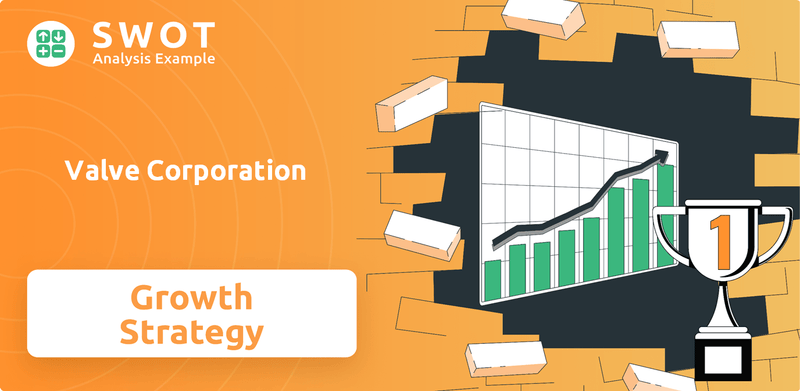
This analysis explores the Valve Corporation SWOT Analysis, delving into Valve's ambitious growth strategy and its future prospects within the dynamic video game industry. We'll examine the Steam Platform Expansion, analyze PC Gaming Market Trends, and explore Valve's innovative approach to game development, including their expansion into the hardware market. Understanding Valve's business development and its ability to adapt to challenges will be key to understanding its long-term vision for gaming.
How Is Valve Corporation Expanding Its Reach?
The expansion initiatives of the company are strategically designed to fuel future growth, primarily focusing on broadening its hardware ecosystem and strengthening its digital distribution platform, Steam. A key element of this strategy involves extending SteamOS to third-party hardware, allowing manufacturers to sell devices with SteamOS pre-installed. This approach aims to expand the ecosystem through partnerships, exemplified by announcements like Lenovo's showcasing of the Legion Go gaming handheld, which will be the first third-party device to feature SteamOS.
This strategic move is intended to make PC gaming more accessible and portable, diversifying revenue streams and staying ahead of industry shifts. By embracing partnerships and expanding its hardware offerings, the company positions itself to capitalize on the evolving gaming landscape, ensuring sustained growth and market leadership. This expansion strategy is a key component of the company's overall business development.
Furthermore, the company is poised to revolutionize the gaming industry with new hardware, including a wireless VR headset (codenamed Decard) and a living room console named Fremont. The Fremont console is designed as a hybrid between a PC and a traditional console, providing easy access to the entire Steam library and offering a plug-and-play experience. These innovations aim to enhance user experience and disrupt the current console market, building on lessons learned from past hardware ventures.
The Steam platform continues to be a central focus for the company's expansion. Strategic partnerships are crucial for improving services, enhancing content delivery, and boosting global sales. This approach helped strengthen Steam's ecosystem in 2023. The company's commitment to enhancing both handheld and virtual reality gaming ensures its continued role as a key player in the gaming industry.
The integration of hardware and software is a key aspect of the company's strategy. The Steam Deck, for example, has been a significant success, with sales figures showing strong market penetration. The company is leveraging its expertise in both hardware and software to create a seamless gaming experience across multiple platforms, including VR and handheld devices. This synergy is a key driver of the company's competitive advantages.
Virtual reality gaming is a critical area of investment. The development of a new wireless VR headset demonstrates the company's commitment to this technology. This initiative is part of a broader strategy to enhance user experience and provide immersive gaming experiences. The company's VR gaming initiatives are designed to capture a significant share of the growing VR market.
The company is actively expanding its international presence. This involves forming strategic partnerships to improve services and boost sales in key global markets. This approach is essential for sustained growth and market leadership. The company's international market strategies are designed to capitalize on the global demand for PC gaming.
The company's expansion strategy focuses on hardware diversification and platform enhancement, including the expansion of SteamOS to third-party hardware, and the development of new hardware like the wireless VR headset (Decard) and the Fremont console. These initiatives are designed to enhance user experience and disrupt the current console market.
- Expanding SteamOS to third-party hardware.
- Developing a new wireless VR headset.
- Launching the Fremont console.
- Forming strategic partnerships for global expansion.
Valve Corporation SWOT Analysis
- Complete SWOT Breakdown
- Fully Customizable
- Editable in Excel & Word
- Professional Formatting
- Investor-Ready Format
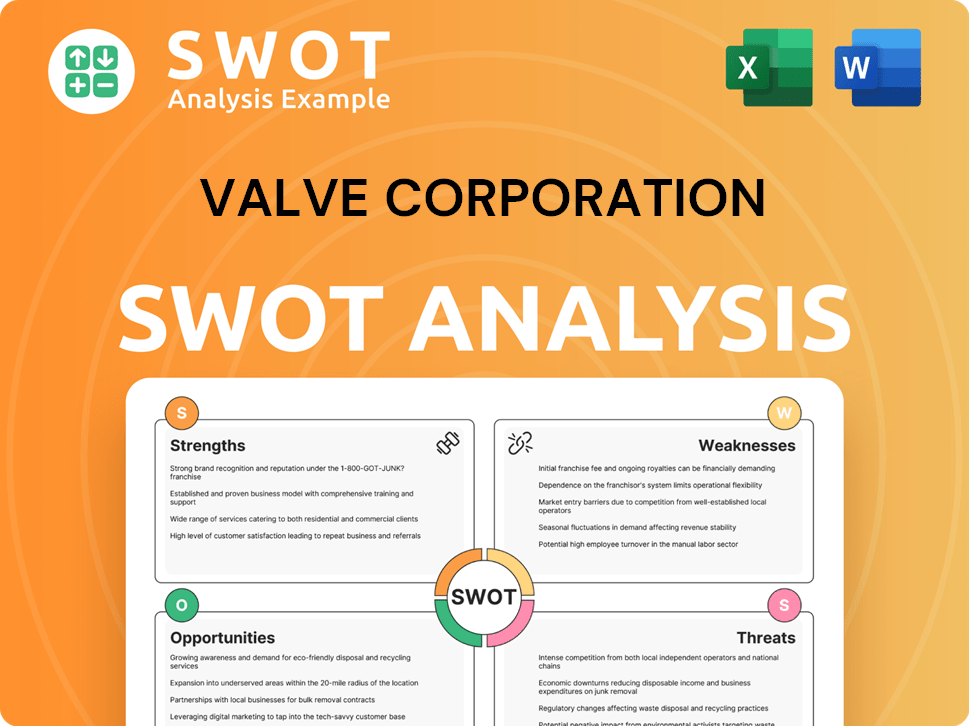
How Does Valve Corporation Invest in Innovation?
Valve's growth strategy heavily relies on innovation and technological advancements. The company consistently invests in research and development, fostering in-house development and strategic collaborations to stay ahead in the competitive video game industry. This approach is evident in its continuous efforts to enhance the Steam platform and expand into new hardware ventures.
Digital transformation is a core element of Valve's business model, with the Steam platform being a prime example. The company's ability to adapt to evolving customer needs and preferences is crucial for its sustained success. Furthermore, Valve's focus on emerging technologies, such as virtual reality and head-mounted displays, positions it at the forefront of immersive gaming experiences.
In 2024, the Steam platform saw significant improvements for both customers and developers, marking it as the 'best year ever' for users buying newly released games. This includes advancements in VR gaming, the Steam Deck, and modifications to demo versions to increase their visibility.
Valve continuously improves the Steam platform to enhance user experience and provide better tools for developers. These enhancements are crucial for maintaining user engagement and attracting new users to the platform.
Valve is heavily invested in virtual reality gaming, developing both hardware and software to create immersive experiences. This focus on VR positions Valve to capitalize on the growing VR gaming market.
The Steam Deck, Valve's handheld gaming device, is a key component of its hardware strategy. Continuous improvements and updates to the Steam Deck enhance its performance and appeal to gamers.
Valve's commitment to innovation is reflected in its robust patent portfolio, particularly in VR and head-mounted displays. Recent patents showcase its technological advancements.
Valve is exploring the potential of a SteamOS phone and providing SteamOS to third-party partners to ensure seamless gaming experiences across devices. This strategy aims to broaden the reach of the Steam ecosystem.
The integration of AI into marketing workflows and the focus on advanced data analytics are trends influencing the broader industry, enhancing product quality and operational efficiency.
Valve's innovation strategy is further highlighted by its patent filings. Recent patent grants in 2025 include 'Folded optics for a head mounted display' (May 6, 2025), 'Position tracking systems and methods for head-mounted display systems' (March 25, 2025), and 'Controller with sensor-rich controls' (February 25, 2025). These patents underscore Valve's commitment to advancing immersive gaming experiences. The company's explorations into a SteamOS phone, which could combine mobile and traditional gaming, further demonstrate its forward-thinking approach. To understand the competitive landscape, it's helpful to examine the Competitors Landscape of Valve Corporation.
Valve's strategic focus on technological innovation and digital transformation is pivotal for its continued growth and success. The company's investments in R&D, in-house development, and collaborations drive its competitive edge in the gaming industry.
- Continuous Enhancement of Steam Platform: Regular updates and improvements to enhance user experience.
- VR Gaming Initiatives: Development of hardware and software for immersive VR experiences.
- Steam Deck Development: Ongoing improvements to the handheld gaming device.
- Patent Portfolio: Securing patents in VR and related technologies to protect innovations.
- SteamOS Expansion: Providing SteamOS to third-party partners to ensure seamless gaming experiences.
- AI and Data Analytics: Integrating AI and data analytics to improve product quality and operational efficiency.
Valve Corporation PESTLE Analysis
- Covers All 6 PESTLE Categories
- No Research Needed – Save Hours of Work
- Built by Experts, Trusted by Consultants
- Instant Download, Ready to Use
- 100% Editable, Fully Customizable
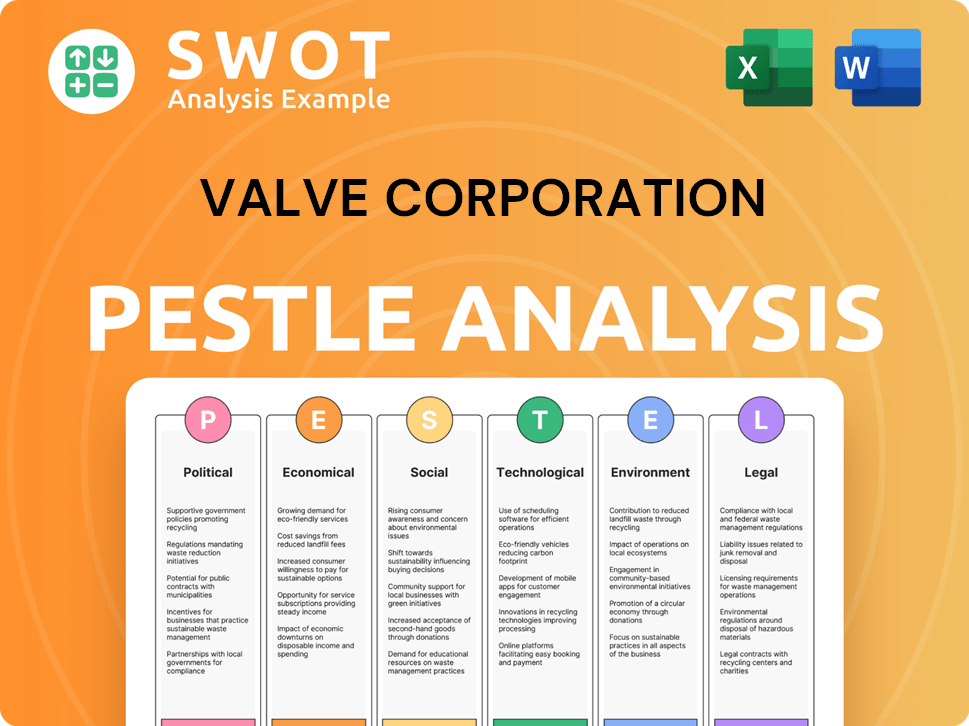
What Is Valve Corporation’s Growth Forecast?
While publicly available financial data for Valve Corporation is limited due to its private status, several indicators point to a robust financial outlook. In November 2024, Forbes estimated the company's revenue at around $5 billion. This figure underscores the significant scale of the company's operations within the gaming industry.
Valve's financial success is further highlighted by its operational efficiency. Despite generating billions in revenue, the company maintains a relatively small workforce. Court documents from 2021 revealed a headcount of just 336 employees, a stark contrast to its larger competitors. This lean structure contributes to high revenue per employee, suggesting strong profitability.
Looking ahead to 2024 and 2025, the company is positioned for continued growth. Steam, its digital distribution platform, experienced its 'best year ever' in 2024 in terms of new game sales. The company's strategic focus on hardware innovations, such as the Steam Deck, and upcoming VR headsets and consoles, is expected to further enhance user engagement and drive revenue within its ecosystem. This focus on both software and hardware positions the company well for future expansion.
The company's revenue is estimated at $5 billion as of November 2024. This demonstrates significant revenue in the gaming industry. The company's revenue is comparable to industry giants like Electronic Arts, which reported $7.5 billion in 2024.
With only 336 employees in 2021, the company operates with remarkable efficiency. This lean structure contributes to high revenue per employee. The company's operational efficiency is a key factor in its financial success.
2024 was Steam's 'best year ever' for new game sales. Over 500 titles earned more than $250,000 in new release sales in 2024. This highlights the significant revenue generated through its digital distribution platform and the company's continued success.
New release revenue in 2024 was ten times higher than in 2014. Over 200 titles earned more than $1 million in 2024. This indicates strong growth in the company's ability to generate revenue from new game releases.
The company's strategic focus includes hardware innovations like the Steam Deck and upcoming VR headsets. These initiatives are designed to enhance user experience and drive further engagement within its ecosystem. The company's approach to game development and its expansion into the hardware market are key to its long-term vision for gaming.
- Steam Deck sales and market share are expected to contribute to revenue growth.
- The company's VR gaming initiatives are poised to capitalize on the growing VR market.
- The company's competitive advantages include its strong brand and loyal user base.
- The company's international market strategies are expected to drive further expansion.
Valve Corporation Business Model Canvas
- Complete 9-Block Business Model Canvas
- Effortlessly Communicate Your Business Strategy
- Investor-Ready BMC Format
- 100% Editable and Customizable
- Clear and Structured Layout
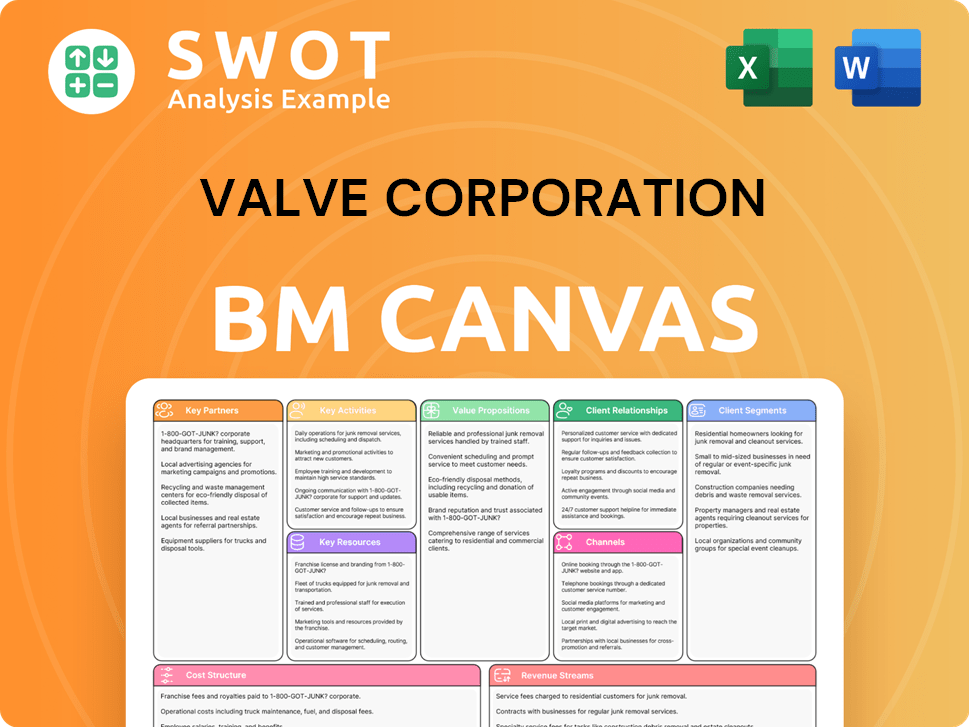
What Risks Could Slow Valve Corporation’s Growth?
The success of Valve Corporation is not without its challenges. The company faces several potential risks and obstacles that could impact its growth and market position. These challenges range from intense competition and regulatory pressures to the rapid evolution of technology and the need for continuous innovation within the video game industry.
One of the most significant hurdles for Valve is the highly competitive nature of the gaming market. The emergence of rival digital storefronts and hardware platforms puts pressure on Valve's Steam platform. The company must continuously adapt and innovate to maintain its competitive edge. Furthermore, antitrust scrutiny and regulatory changes pose additional risks, as seen with recent legal actions and governmental warnings.
Technological disruption is another ongoing concern for Valve. The fast-paced advancements in gaming technology, such as graphics card development, require constant adaptation. Valve must ensure compatibility and deliver on the potential of new technologies. Additionally, cybersecurity threats and data privacy concerns are critical in the digital distribution space, adding to the complexity of managing its operations.
The PC Gaming Market Analysis reveals a dynamic landscape with strong competition. Valve's Steam platform competes with other digital storefronts. Maintaining market share requires continuous innovation and strategic adaptation.
Valve Corporation Growth Strategy faces risks from regulatory changes and antitrust scrutiny. A consumer class action lawsuit was filed in August 2024. US Senator warned of increased government scrutiny in November 2024.
The rapid pace of technological advancements poses a challenge. Constant adaptation is needed to ensure compatibility with new technologies. Cybersecurity threats and data privacy are critical concerns.
Previous attempts to enter the hardware market have faced challenges. The Steam Machines failed due to a lack of control and high pricing. Learning from past mistakes is crucial for current hardware initiatives.
Valve's relatively small employee count, reported as 336 in 2021, could pose a risk. Managing all operations and maintenance during business expansion requires efficient resource allocation.
To mitigate risks, Valve is focusing on creating a more cohesive user experience. This includes new hardware and expanding its ecosystem through partnerships. These initiatives support the Valve Company Future Prospects.
Valve's approach to Steam Platform Expansion and Valve Business Development may include strategic acquisitions. These acquisitions could help Valve expand into new markets or technologies. Further acquisitions could enhance Valve's competitive advantages.
Valve's expansion into the hardware market, as seen with the Steam Deck, is a key strategy. The success of the Steam Deck and its Steam Deck sales and market share is critical. Valve's hardware initiatives are an important part of its long-term vision for gaming.
For a deeper understanding of Valve's business model, consider reading about the Revenue Streams & Business Model of Valve Corporation. This provides insights into how Valve generates revenue and its overall business strategy.
Valve Corporation Porter's Five Forces Analysis
- Covers All 5 Competitive Forces in Detail
- Structured for Consultants, Students, and Founders
- 100% Editable in Microsoft Word & Excel
- Instant Digital Download – Use Immediately
- Compatible with Mac & PC – Fully Unlocked
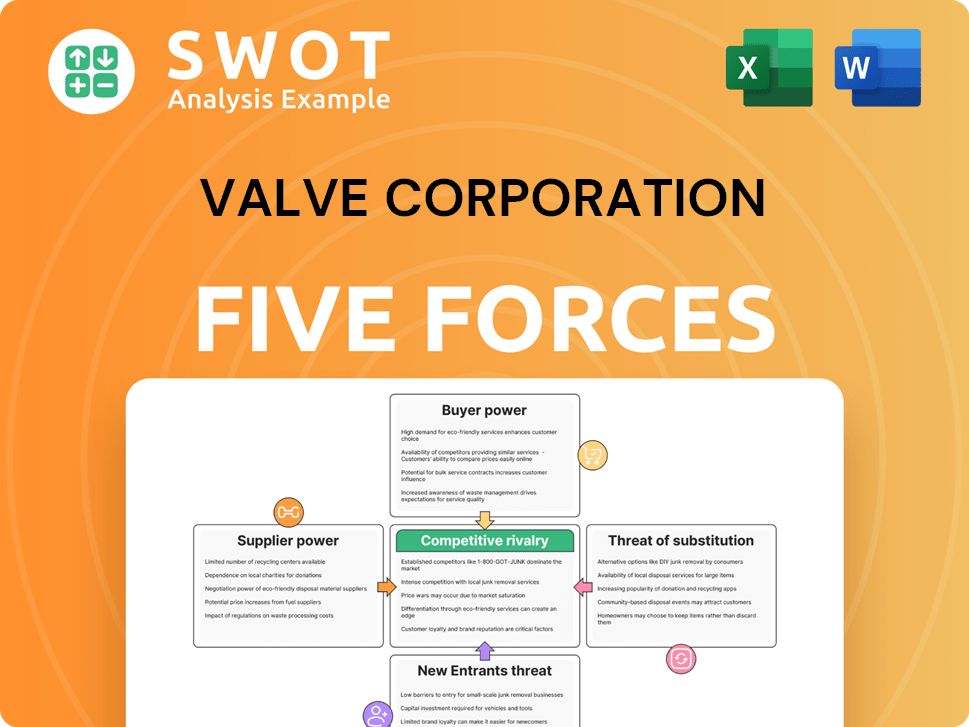
Related Blogs
- What are Mission Vision & Core Values of Valve Corporation Company?
- What is Competitive Landscape of Valve Corporation Company?
- How Does Valve Corporation Company Work?
- What is Sales and Marketing Strategy of Valve Corporation Company?
- What is Brief History of Valve Corporation Company?
- Who Owns Valve Corporation Company?
- What is Customer Demographics and Target Market of Valve Corporation Company?
Disclaimer
All information, articles, and product details provided on this website are for general informational and educational purposes only. We do not claim any ownership over, nor do we intend to infringe upon, any trademarks, copyrights, logos, brand names, or other intellectual property mentioned or depicted on this site. Such intellectual property remains the property of its respective owners, and any references here are made solely for identification or informational purposes, without implying any affiliation, endorsement, or partnership.
We make no representations or warranties, express or implied, regarding the accuracy, completeness, or suitability of any content or products presented. Nothing on this website should be construed as legal, tax, investment, financial, medical, or other professional advice. In addition, no part of this site—including articles or product references—constitutes a solicitation, recommendation, endorsement, advertisement, or offer to buy or sell any securities, franchises, or other financial instruments, particularly in jurisdictions where such activity would be unlawful.
All content is of a general nature and may not address the specific circumstances of any individual or entity. It is not a substitute for professional advice or services. Any actions you take based on the information provided here are strictly at your own risk. You accept full responsibility for any decisions or outcomes arising from your use of this website and agree to release us from any liability in connection with your use of, or reliance upon, the content or products found herein.